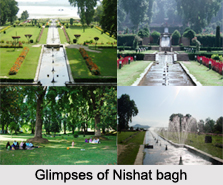 Architecture of Nishat Bagh exhibits the conventional architecture of Mughal era that is present in Mughal Gardens, Delhi. The architectural layout of Nishat Bagh was based on the basic conceptual model of the Persian garden. Later, it had to be remodelled to fit the topographic and water source conditions at the site chosen in the Kashmir valley in Jammu and Kashmir.
Architecture of Nishat Bagh exhibits the conventional architecture of Mughal era that is present in Mughal Gardens, Delhi. The architectural layout of Nishat Bagh was based on the basic conceptual model of the Persian garden. Later, it had to be remodelled to fit the topographic and water source conditions at the site chosen in the Kashmir valley in Jammu and Kashmir.
Patterns in Architecture of Nishat Bagh
The plan of Nishat Bagh instead of being central with four radiating arms in a square pattern as in the case of Chahar, was changed to an axial stream flow design to fit the hill condition with water source originating at the top of the hill end. This resulted in planning a rectangular layout rather than a square layout. This helped in dispensing with the long side arms. Thus, a rectangular layout with east-west length of 548 metres (1,798 ft) and width of 338 metres (1,109 ft) was adopted.
Terraces in Nishat Bagh
Nishat Bagh has a broad cascade of terraces lined with avenues of chinar and cypress trees, which starts from the lakeshore and reaches up to an artificial facade at the hill end. Rising from the edge of the Dal Lake, Nishat Bagh has 12 terraces representing twelve Zodiacal signs. However, it has only two sections, namely the public garden and the private garden for the Zanana or harem vis-a-vis the four sections of the Shalimar Bagh. This difference is attributed to the fact that the Shalimar Bagh catered to the Mughal Emperor, while Nishad Bagh belonged to a man of his court, a noble.
The first terrace is a water collection chamber that is also linked to the side flow from the garden. The second terrace is accessed through a gate. This terrace has five fountains that supply water from the third terrace, from where it flowed to the lowest terrace. The third terrace has a different design. The water chute has five arched open niches in the front and similar niches on the sides. A pavilion (baradari), a two-storied structure, which existed here when it was originally built, has since been dismantled. Stairways, on either side of the channel lead to the third terrace, which has a square chamber with five fountains. Moving up the flight of steps (four steps) on either side of the channel leads to the fourth terrace. The fourth terrace has two levels namely, a water channel and a square pool. Stairways with 7 steps lead to the fifth terrace. The fifth terrace is a stone bench provided across the channel to enjoy the scenic beauty. This also has a square chamber with five fountains.
The sixth terrace is at two levels with five fountains and distinctive paving pattern. The seventh terrace has the same pattern continuing. The eighth terrace is only a water channel or chute. In the ninth terrace, at the end of two stairways, there is an octagonal bench. The pool in this terrace has nine fountains. The stairways to the tenth terrace are along the side retaining walls where only the water chute with fountains is provided. The engraved paths lead to an impressive eleventh terrace, which has twenty five fountains in a pool. Up from this dramatic terrace is the last one. The zenana chamber, the twelfth terrace, is covered in the front by 5.5 metres (18 ft) high wall with a facade of blind arches. Only one arch in this blind facade provides an opening to the twelfth terrace. Two small octagonal towers on either side of the retaining walls provide views of the lower level terraces. A two-storey pavilion here is surrounded by a lovely garden with lush plantings.
Similarities with Shalimar Gardens and Nishat Bagh
There are some similarities with the Shalimar Bagh, such as the polished stone channel and terraces. The source of water supply to the two gardens is the same. Built in an east-west direction, the top terrace has the Zenana garden while the lowest terrace is connected to the Dal Lake.
Canal of Nishat Bagh
The central canal of Nishat Bagh that runs through the garden from the top end, is 4 metres (13 ft) wide and has a water depth of 20 centimetres (7.9 in). The water of Nishat Bagh flows down in a cascade from the top to the first terrace at the road level, which could be also approached from the Dal Lake through a shikara ride.
Water Flow to Nishat Bagh
The water flow of Nishat Bagh from one terrace to the next has over stepped stone ramps that provide the sparkle to the flow. At all the terraces fountains with pools are provided, along the water channel. At channel crossings, benches are provided for people to sit and enjoy the beauty of the garden and the cascading flows and fountain jets.
Related Articles
Jammu and Kashmir
Tourism In Jammu And Kashmir
Nishat Bagh
Dal Lake
Tourism In Srinagar, Jammu And Kashmir



















